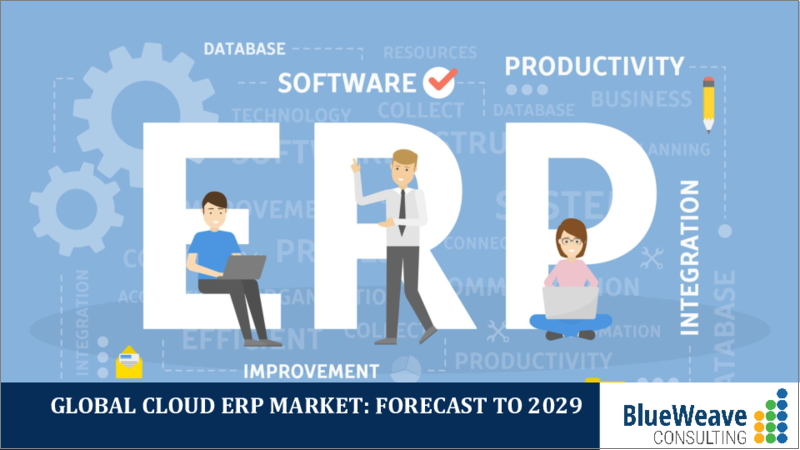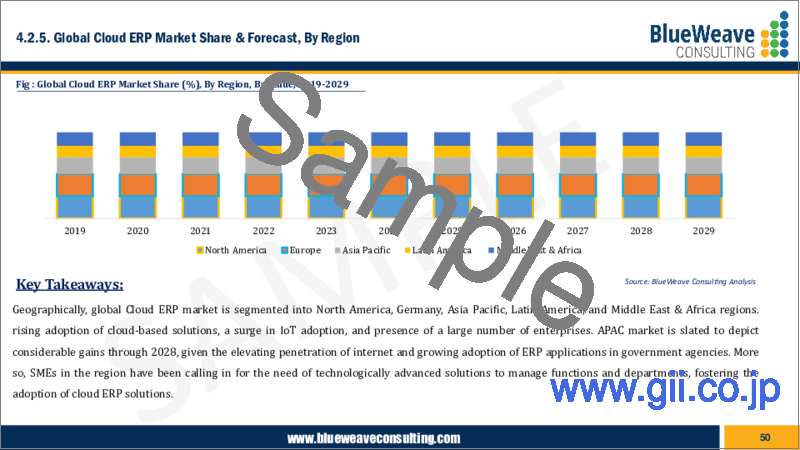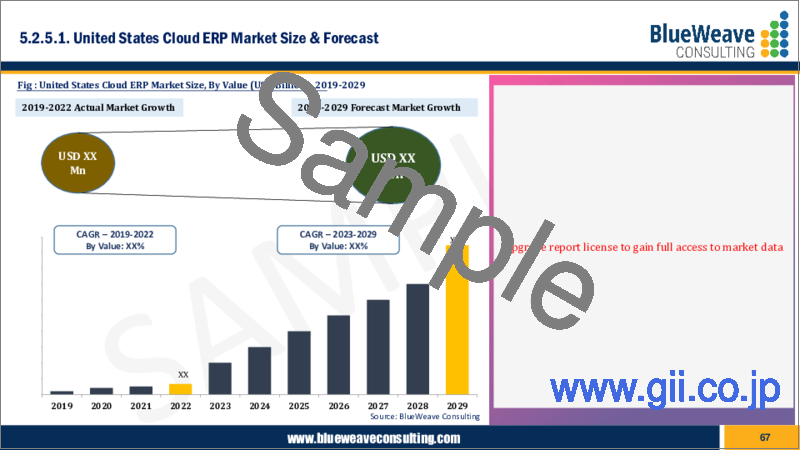|
|
市場調査レポート
商品コード
1249976
クラウドERPの世界市場 - 規模、シェア、動向分析、機会、予測:コンポーネント別、ビジネス機能別、組織規模別、業界別、地域別(2019年~2029年)Cloud ERP Market - Global Size, Share, Trend Analysis, Opportunity and Forecast Report, 2019-2029, Segmented By Component ; By Business Function ; By Organization Size ; By Vertical ; By Region |
||||||
| クラウドERPの世界市場 - 規模、シェア、動向分析、機会、予測:コンポーネント別、ビジネス機能別、組織規模別、業界別、地域別(2019年~2029年) |
|
出版日: 2023年03月21日
発行: Blueweave Consulting
ページ情報: 英文 400 Pages
納期: 2~3営業日
|
- 全表示
- 概要
- 目次
世界のクラウドERPの市場規模は、2022年の647億米ドルから2029年までに1,747億3,000万米ドルに達し、2023年~2029年の予測期間中にCAGRで15.37%の健全な成長が予測されています。COVID-19パンデミックの発生を受けた、オンプレミスからクラウドERPへの急速な転換が、市場の主な成長要因の1つとなっています。
当レポートでは、世界のクラウドERP市場について調査分析し、市場規模と予測、セグメント分析、地域分析、企業プロファイルなどを提供しています。
目次
第1章 調査の枠組み
第2章 エグゼクティブサマリー
第3章 世界のクラウドERP市場の考察
- 業界バリューチェーン分析
- DROC分析
- 促進要因
- 抑制要因
- 機会
- 課題
- 技術の進歩/最近の発展
- 規制の枠組み
- ポーターのファイブフォース分析
第4章 世界のクラウドERP市場の概要
- 市場規模と予測(2019年~2029年)
- 金額
- 市場シェアと予測
- コンポーネント別
- ソリューション
- サービス
- ビジネス機能別
- 会計、財務
- セールス、マーケティング
- 在庫、注文管理
- 組織規模別
- 中小企業
- 大企業
- 業界別
- BFSI
- IT、ITES
- 政府、公共部門
- 製造
- 小売、消費財
- 医療、ライフサイエンス
- エネルギー、公益事業
- その他
- 地域別
- 北米
- 欧州
- アジア太平洋
- ラテンアメリカ
- 中東・アフリカ
- コンポーネント別
第5章 北米のクラウドERP市場
- 市場規模と予測(2019年~2029年)
- 金額
- 市場シェアと予測
- コンポーネント別
- ビジネス機能別
- 組織規模別
- 業界別
- 国別
- 米国
- カナダ
第6章 欧州のクラウドERP市場
- 市場規模と予測(2019年~2029年)
- 金額
- 市場シェアと予測
- コンポーネント別
- ビジネス機能別
- 組織規模別
- 業界別
- 国別
- ドイツ
- 英国
- イタリア
- フランス
- スペイン
- ベルギー
- ロシア
- オランダ
- その他の欧州
第7章 アジア太平洋のクラウドERP市場
- 市場規模と予測(2019年~2029年)
- 金額
- 市場シェアと予測
- コンポーネント別
- ビジネス機能別
- 組織規模別
- 業界別
- 国別
- 中国
- インド
- 日本
- 韓国
- オーストラリア・ニュージーランド
- インドネシア
- マレーシア
- シンガポール
- ベトナム
- その他のアジア太平洋
第8章 ラテンアメリカのクラウドERP市場
- 市場規模と予測(2019年~2029年)
- 金額
- 市場シェアと予測
- コンポーネント別
- ビジネス機能別
- 組織規模別
- 業界別
- 国別
- ブラジル
- メキシコ
- アルゼンチン
- ペルー
- その他のラテンアメリカ
第9章 中東・アフリカのクラウドERP市場
- 市場規模と予測(2019年~2029年)
- 金額
- 市場シェアと予測
- コンポーネント別
- ビジネス機能別
- 組織規模別
- 業界別
- 国別
- サウジアラビア
- アラブ首長国連邦
- カタール
- クウェート
- 南アフリカ
- ナイジェリア
- アルジェリア
- その他の中東・アフリカ
第10章 競合情勢
- 主要企業とそのコンポーネントのリスト
- 世界のクラウドERP企業の市場シェア分析(2022年)
- 競合ベンチマーキング:経営パラメーター別
- 主な戦略的展開(合併、買収、パートナーシップなど)
第11章 世界のクラウドERP市場に対するCOVID-19の影響
第12章 企業プロファイル(企業の概要、財務マトリックス、競合情勢、主な人材、主な競合、連絡先、戦略的見通し、SWOT分析)
- Oracle
- Microsoft
- SAP
- IFS
- Sage Group plc
- Workday, Inc.
- Plex Systems.
- Ramco Systems.
- Epicor Software Corporation
- Tally Solutions Private Limited
- Odoo
- SYSPRO
- Tyler Technologies
- MIE Solutions
- Genius Solution, Inc.
- Brightpearl
- Deltek, Inc.
- QAD Inc.
- VIENNA Advantage
- その他の著名な企業
第13章 主な戦略的推奨事項
第14章 調査手法
Global Cloud ERP Market Size More Than Doubles to Touch USD 175 Billion by 2029.
Global cloud ERP market is gaining traction because of the implementation of ERP systems on cloud to perform core operations and rising government investments in digitalization.
BlueWeave Consulting, a leading strategic consulting and market research firm, in its recent study, estimated the global cloud ERP market size at USD 64.7 billion in 2022. During the forecast period between 2023 and 2029, the global cloud ERP market size is projected to grow at a robust CAGR of 15.37% reaching a value of USD 174.73 billion by 2029. Rapid conversion from on-premises to cloud ERP following the COVID-19 pandemic outbreak is one of the key growth drivers for the global cloud ERP market. Cloud ERP has an increasing market demand among both large and small & medium-sized businesses due to its lower upfront costs, quicker implementation, and less intense use of human and physical resources.
Global Cloud ERP Market - Overview:
Cloud ERP (enterprise resource planning) software runs on a secure server and is easily accessible through the Internet. Cloud ERP solutions provide a more effective method by enabling businesses to utilize enormous computer capacity. Moving from on-premises to cloud ERP often provides cheaper upfront costs, quicker deployment, and less intensive use of human and physical resources. One of the numerous security advantages that top-notch cloud-based ERP software offers is disaster recovery. In the case of a significant interruption, it refers to the collection of rules, instruments, and practices used by the vendor to restore your data and systems.
Global Cloud ERP Market - By Organization Size
Based on organization size, the global cloud ERP market is segmented into SMEs and large enterprises. The large enterprises segment holds a higher share in the global cloud ERP market. Large businesses may gather, store, and analyze data from all of their activities in one central area using an ERP system, giving them the visibility they need to make more informed decisions. A company may obtain real-time information and provide more helpful reports thanks to that consolidated data. However, SMEs are projected to grow at faster rate during the forecast period.
Impact of COVID-19 on Global Cloud ERP Market
The global cloud ERP market witnessed tremendous growth post the COVID-19 pandemic outbreak. The key component of cloud-based ERP software is a monthly or subscription service. As the system is operated online, the business owner doesn't need to invest in physical assets, which saves money that may be used in other departments of the company to combat the pandemic's impacts on the company. ERP can be used by remote workers since they require a single source of precise, real-time data. By enabling employees to handle company activities proactively and assisting them in making the best choice fast, the system successfully lowers administrative and operational expenses.
Competitive Landscape
Major players operating in the global cloud ERP market include Oracle, Microsoft, SAP, IFS, Sage Group plc, Workday, Inc., Plex Systems., Ramco Systems., Epicor Software Corporation, Tally Solutions Private Limited, Odoo, SYSPRO, Tyler Technologies, MIE Solutions, Genius Solution, Inc., Brightpearl, Deltek, Inc., QAD Inc., and VIENNA Advantage.
To further enhance their market share, these companies employ various strategies, including mergers and acquisitions, partnerships, joint ventures, license agreements, and new product launches.
The in-depth analysis of the report provides information about growth potential, upcoming trends, and the Global Cloud ERP Market. It also highlights the factors driving forecasts of total market size. The report promises to provide recent technology trends in the Global Cloud ERP Market and industry insights to help decision-makers make sound strategic decisions. Furthermore, the report also analyzes the growth drivers, challenges, and competitive dynamics of the market.
Table of Contents
1. Research Framework
- 1.1. Research Objective
- 1.2. Product Overview
- 1.3. Market Segmentation
2. Executive Summary
3. Global Cloud ERP Market Insights
- 3.1. Industry Value Chain Analysis
- 3.2. DROC Analysis
- 3.2.1. Growth Drivers
- 3.2.1.1. Implementation of ERP Systems to Perform Core Operations
- 3.2.1.2. Advancement in Technology
- 3.2.2. Restraints
- 3.2.2.1. Limited Customization Options Available for ERP Solutions
- 3.2.3. Opportunities
- 3.2.3.1. Rising Government Investment on Digitalization
- 3.2.4. Challenges
- 3.2.4.1. Security Concerns
- 3.2.1. Growth Drivers
- 3.3. Technology Advancements/Recent Developments
- 3.4. Regulatory Framework
- 3.5. Porter's Five Forces Analysis
- 3.5.1. Bargaining Power of Suppliers
- 3.5.2. Bargaining Power of Buyers
- 3.5.3. Threat of New Entrants
- 3.5.4. Threat of Substitutes
- 3.5.5. Intensity of Rivalry
4. Global Cloud ERP Market Overview
- 4.1. Market Size & Forecast, 2019-2029
- 4.1.1. By Value (USD Million)
- 4.2. Market Share & Forecast
- 4.2.1. By Component
- 4.2.1.1. Solutions
- 4.2.1.2. Services
- 4.2.2. By Business Function
- 4.2.2.1. Accounting and Finance
- 4.2.2.2. Sales and Marketing
- 4.2.2.3. Inventory and Order Management
- 4.2.3. By Organization Size
- 4.2.3.1. SMEs
- 4.2.3.2. Large Enterprises
- 4.2.4. By Vertical
- 4.2.4.1. BFSI
- 4.2.4.2. IT and ITeS
- 4.2.4.3. Government and Public Sector
- 4.2.4.4. Manufacturing
- 4.2.4.5. Retail and Consumer Goods
- 4.2.4.6. Healthcare and Life Sciences
- 4.2.4.7. Energy and Utilities
- 4.2.4.8. Others
- 4.2.5. By Region
- 4.2.5.1. North America
- 4.2.5.2. Europe
- 4.2.5.3. Asia Pacific (APAC)
- 4.2.5.4. Latin America (LATAM)
- 4.2.5.5. Middle East and Africa (MEA)
- 4.2.1. By Component
5. North America Cloud ERP Market
- 5.1. Market Size & Forecast, 2019-2029
- 5.1.1. By Value (USD Million)
- 5.2. Market Share & Forecast
- 5.2.1. By Component
- 5.2.2. By Business Function
- 5.2.3. By Organization Size
- 5.2.4. By Vertical
- 5.2.5. By Country
- 5.2.5.1. United States
- 5.2.5.1.1. By Component
- 5.2.5.1.2. By Business Function
- 5.2.5.1.3. By Organization Size
- 5.2.5.1.4. By Vertical
- 5.2.5.2. Canada
- 5.2.5.2.1. By Component
- 5.2.5.2.2. By Business Function
- 5.2.5.2.3. By Organization Size
- 5.2.5.2.4. By Vertical
6. Europe Cloud ERP Market
- 6.1. Market Size & Forecast, 2019-2029
- 6.1.1. By Value (USD Million)
- 6.2. Market Share & Forecast
- 6.2.1. By Component
- 6.2.2. By Business Function
- 6.2.3. By Organization Size
- 6.2.4. By Vertical
- 6.2.5. By Country
- 6.2.5.1. Germany
- 6.2.5.1.1. By Component
- 6.2.5.1.2. By Business Function
- 6.2.5.1.3. By Organization Size
- 6.2.5.1.4. By Vertical
- 6.2.5.2. United Kingdom
- 6.2.5.2.1. By Component
- 6.2.5.2.2. By Business Function
- 6.2.5.2.3. By Organization Size
- 6.2.5.2.4. By Vertical
- 6.2.5.3. Italy
- 6.2.5.3.1. By Component
- 6.2.5.3.2. By Business Function
- 6.2.5.3.3. By Organization Size
- 6.2.5.3.4. By Vertical
- 6.2.5.4. France
- 6.2.5.4.1. By Component
- 6.2.5.4.2. By Business Function
- 6.2.5.4.3. By Organization Size
- 6.2.5.4.4. By Vertical
- 6.2.5.5. Spain
- 6.2.5.5.1. By Component
- 6.2.5.5.2. By Business Function
- 6.2.5.5.3. By Organization Size
- 6.2.5.5.4. By Vertical
- 6.2.5.6. Belgium
- 6.2.5.6.1. By Component
- 6.2.5.6.2. By Business Function
- 6.2.5.6.3. By Organization Size
- 6.2.5.6.4. By Vertical
- 6.2.5.7. Russia
- 6.2.5.7.1. By Component
- 6.2.5.7.2. By Business Function
- 6.2.5.7.3. By Organization Size
- 6.2.5.7.4. By Vertical
- 6.2.5.8. The Netherlands
- 6.2.5.8.1. By Component
- 6.2.5.8.2. By Business Function
- 6.2.5.8.3. By Organization Size
- 6.2.5.8.4. By Vertical
- 6.2.5.9. Rest of Europe
- 6.2.5.9.1. By Component
- 6.2.5.9.2. By Business Function
- 6.2.5.9.3. By Organization Size
- 6.2.5.9.4. By Vertical
7. Asia-Pacific Cloud ERP Market
- 7.1. Market Size & Forecast, 2019-2029
- 7.1.1. By Value (USD Million)
- 7.2. Market Share & Forecast
- 7.2.1. By Component
- 7.2.2. By Business Function
- 7.2.3. By Organization Size
- 7.2.4. By Vertical
- 7.2.5. By Country
- 7.2.5.1. China
- 7.2.5.1.1. By Component
- 7.2.5.1.2. By Business Function
- 7.2.5.1.3. By Organization Size
- 7.2.5.1.4. By Vertical
- 7.2.5.2. India
- 7.2.5.2.1. By Component
- 7.2.5.2.2. By Business Function
- 7.2.5.2.3. By Organization Size
- 7.2.5.2.4. By Vertical
- 7.2.5.3. Japan
- 7.2.5.3.1. By Component
- 7.2.5.3.2. By Business Function
- 7.2.5.3.3. By Organization Size
- 7.2.5.3.4. By Vertical
- 7.2.5.4. South Korea
- 7.2.5.4.1. By Component
- 7.2.5.4.2. By Business Function
- 7.2.5.4.3. By Organization Size
- 7.2.5.4.4. By Vertical
- 7.2.5.5. Australia & New Zealand
- 7.2.5.5.1. By Component
- 7.2.5.5.2. By Business Function
- 7.2.5.5.3. By Organization Size
- 7.2.5.5.4. By Vertical
- 7.2.5.6. Indonesia
- 7.2.5.6.1. By Component
- 7.2.5.6.2. By Business Function
- 7.2.5.6.3. By Organization Size
- 7.2.5.6.4. By Vertical
- 7.2.5.7. Malaysia
- 7.2.5.7.1. By Component
- 7.2.5.7.2. By Business Function
- 7.2.5.7.3. By Organization Size
- 7.2.5.7.4. By Vertical
- 7.2.5.8. Singapore
- 7.2.5.8.1. By Component
- 7.2.5.8.2. By Business Function
- 7.2.5.8.3. By Organization Size
- 7.2.5.8.4. By Vertical
- 7.2.5.9. Vietnam
- 7.2.5.9.1. By Component
- 7.2.5.9.2. By Business Function
- 7.2.5.9.3. By Organization Size
- 7.2.5.9.4. By Vertical
- 7.2.5.10. Rest of APAC
- 7.2.5.10.1. By Component
- 7.2.5.10.2. By Business Function
- 7.2.5.10.3. By Organization Size
- 7.2.5.10.4. By Vertical
8. Latin America Cloud ERP Market
- 8.1. Market Size & Forecast, 2019-2029
- 8.1.1. By Value (USD Million)
- 8.2. Market Share & Forecast
- 8.2.1. By Component
- 8.2.2. By Business Function
- 8.2.3. By Organization Size
- 8.2.4. By Vertical
- 8.2.5. By Country
- 8.2.5.1. Brazil
- 8.2.5.1.1. By Component
- 8.2.5.1.2. By Business Function
- 8.2.5.1.3. By Organization Size
- 8.2.5.1.4. By Vertical
- 8.2.5.2. Mexico
- 8.2.5.2.1. By Component
- 8.2.5.2.2. By Business Function
- 8.2.5.2.3. By Organization Size
- 8.2.5.2.4. By Vertical
- 8.2.5.3. Argentina
- 8.2.5.3.1. By Component
- 8.2.5.3.2. By Business Function
- 8.2.5.3.3. By Organization Size
- 8.2.5.3.4. By Vertical
- 8.2.5.4. Peru
- 8.2.5.4.1. By Component
- 8.2.5.4.2. By Business Function
- 8.2.5.4.3. By Organization Size
- 8.2.5.4.4. By Vertical
- 8.2.5.5. Rest of LATAM
- 8.2.5.5.1. By Component
- 8.2.5.5.2. By Business Function
- 8.2.5.5.3. By Organization Size
- 8.2.5.5.4. By Vertical
9. Middle East & Africa Cloud ERP Market
- 9.1. Market Size & Forecast, 2019-2029
- 9.1.1. By Value (USD Million)
- 9.2. Market Share & Forecast
- 9.2.1. By Component
- 9.2.2. By Business Function
- 9.2.3. By Organization Size
- 9.2.4. By Vertical
- 9.2.5. By Country
- 9.2.5.1. Saudi Arabia
- 9.2.5.1.1. By Component
- 9.2.5.1.2. By Business Function
- 9.2.5.1.3. By Organization Size
- 9.2.5.1.4. By Vertical
- 9.2.5.2. UAE
- 9.2.5.2.1. By Component
- 9.2.5.2.2. By Business Function
- 9.2.5.2.3. By Organization Size
- 9.2.5.2.4. By Vertical
- 9.2.5.3. Qatar
- 9.2.5.3.1. By Component
- 9.2.5.3.2. By Business Function
- 9.2.5.3.3. By Organization Size
- 9.2.5.3.4. By Vertical
- 9.2.5.4. Kuwait
- 9.2.5.4.1. By Component
- 9.2.5.4.2. By Business Function
- 9.2.5.4.3. By Organization Size
- 9.2.5.4.4. By Vertical
- 9.2.5.5. South Africa
- 9.2.5.5.1. By Component
- 9.2.5.5.2. By Business Function
- 9.2.5.5.3. By Organization Size
- 9.2.5.5.4. By Vertical
- 9.2.5.6. Nigeria
- 9.2.5.6.1. By Component
- 9.2.5.6.2. By Business Function
- 9.2.5.6.3. By Organization Size
- 9.2.5.6.4. By Vertical
- 9.2.5.7. Algeria
- 9.2.5.7.1. By Component
- 9.2.5.7.2. By Business Function
- 9.2.5.7.3. By Organization Size
- 9.2.5.7.4. By Vertical
- 9.2.5.8. Rest of MEA
- 9.2.5.8.1. By Component
- 9.2.5.8.2. By Business Function
- 9.2.5.8.3. By Organization Size
- 9.2.5.8.4. By Vertical
10. Competitive Landscape
- 10.1. List of Key Players and Their Components
- 10.2. Global Cloud ERP Company Market Share Analysis, 2022
- 10.3. Competitive Benchmarking, By Operating Parameters
- 10.4. Key Strategic Developments (Mergers, Acquisitions, Partnerships, etc.)
11. Impact of Covid-19 on Global Cloud ERP Market
12. Company Profile (Company Overview, Financial Matrix, Competitive Landscape, Key Personnel, Key Competitors, Contact Address, Strategic Outlook, SWOT Analysis)
- 12.1. Oracle
- 12.2. Microsoft
- 12.3. SAP
- 12.4. IFS
- 12.5. Sage Group plc
- 12.6. Workday, Inc.
- 12.7. Plex Systems.
- 12.8. Ramco Systems.
- 12.9. Epicor Software Corporation
- 12.10. Tally Solutions Private Limited
- 12.11. Odoo
- 12.12. SYSPRO
- 12.13. Tyler Technologies
- 12.14. MIE Solutions
- 12.15. Genius Solution, Inc.
- 12.16. Brightpearl
- 12.17. Deltek, Inc.
- 12.18. QAD Inc.
- 12.19. VIENNA Advantage
- 12.20. Other Prominent Players
13. Key Strategic Recommendations
14. Research Methodology
- 14.1. Qualitative Research
- 14.1.1. Primary & Secondary Research
- 14.2. Quantitative Research
- 14.3. Market Breakdown & Data Triangulation
- 14.3.1. Secondary Research
- 14.3.2. Primary Research
- 14.4. Breakdown of Primary Research Respondents, By Region
- 14.5. Assumptions & Limitations




